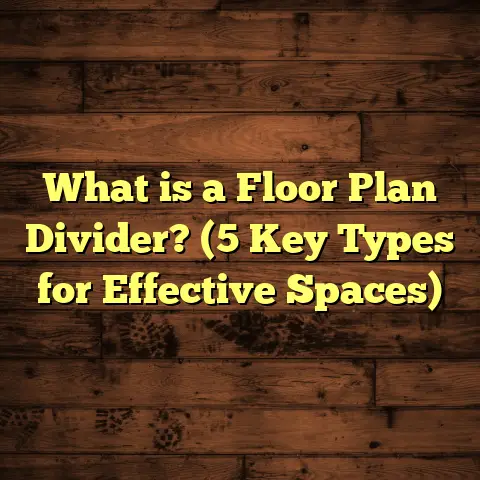What is One-Floor Living? (5 Benefits for Easier Living)
Have you ever wondered how different your daily life could be if every part of your home was just a few steps away? No stairs to climb, no worries about carrying heavy things up or down—just a smooth, single-level flow. Imagine the ease of moving through your living room, kitchen, and bedroom without a single step between them. That idea is the essence of one-floor living, a concept that’s gaining popularity for good reasons. So, what exactly is one-floor living, and why might it be a game changer for how you experience your home?
What is One-Floor Living?
One-floor living means having all your essential living spaces arranged on a single floor. Think bedrooms, kitchen, bathrooms, living areas—all on the same level without any stairs inside the home. This could be in a ranch-style house, a bungalow, or a custom-built modern home designed with this principle in mind.
Unlike multi-story homes where bedrooms are often upstairs and common spaces downstairs, one-floor living removes the vertical barriers between areas. This makes everything easily reachable without climbing stairs or navigating steps.
When I first encountered this concept professionally, I was working with a client who needed a home that could accommodate limited mobility. We focused on designing every element to be accessible on one floor. Watching their independence and comfort improve made me appreciate how much of an impact this design can have.
The trend toward one-floor living is growing. According to the National Association of Home Builders, about 30% of new homes built in 2023 were single-story designs. The rise is driven by aging populations wanting to stay in their homes longer and younger homeowners appreciating the convenience.
Why Does One-Floor Living Matter?
You might ask, “Is it really that different?” Well, yes. It’s not just about simplicity; it’s about safety, convenience, cost savings, and long-term planning all wrapped into one.
Let’s break down some benefits that make one-floor living worth considering:
1. Better Accessibility and Reduced Risk of Injury
Stairs are one of the trickiest parts of a home for many people—kids learning to walk, aging parents with weaker joints, or anyone recovering from injury. The risk of falls is real. In fact, the CDC reports over 3 million emergency department visits yearly among older adults due to falls at home, many involving stairs.
Removing stairs altogether means less chance of accidents from tripping or slipping. For families with young children, it’s also peace of mind knowing there are no dangerous drop-offs or staircases to worry about.
I remember working with a family who had an infant and an elderly grandparent living under the same roof. They switched to a ranch-style home with everything on one floor. The grandmother felt safer moving around without assistance, and the parents found it easier to watch their child explore freely.
2. Daily Convenience that Adds Up
Think about how often you carry laundry baskets up and down stairs or bring groceries inside while juggling bags and kids. It’s exhausting!
Having all rooms on one floor eliminates these hassles. You can move from kitchen to dining room to living room without any obstacles. Chores like cleaning or organizing become less daunting because everything is nearby.
Clients often tell me how much “lighter” their day feels when they don’t have to haul things between floors constantly. It might seem like a small thing but adds up quickly over weeks and months.
3. Simplified Cleaning and Maintenance
Cleaning multiple floors means lugging heavy vacuums or mops around stairs. Plus, maintaining two floors can be more expensive because repairs might differ by level.
With one-floor living, cleaning is straightforward. You can do the job faster and spend less energy managing your home. When renovations or flooring replacements are needed, working on one level reduces complexity—and often cost.
I once helped a couple replace old carpet with hardwood throughout their entire ranch home. The process was smoother than expected because there were no staircases to work around, which kept labor costs down.
4. Energy Efficiency Benefits
Heating and cooling a multi-story home can be tricky. Warm air rises upstairs in winter, leaving lower floors chilly; summer heat tends to settle upstairs too.
One-floor homes usually have more even temperature distribution because there’s no vertical separation. The Department of Energy notes that simpler floor plans often lead to lower energy bills since HVAC systems can operate more efficiently.
I’ve seen clients save up to 15% on monthly energy costs after switching from two-story homes to well-insulated single-level designs with improved airflow.
5. Flexibility for Aging in Place
Many homeowners want a house that grows with them. Planning for aging in place means designing spaces that are easy to navigate later in life without major renovations.
One-floor living naturally supports this by eliminating stairs and allowing wider hallways and doorways for wheelchairs or walkers if needed.
According to AARP surveys, nearly 90% of adults over 65 want to remain in their current homes as they age—making adaptable single-story homes valuable assets.
When I help clients plan these spaces, we focus on features like no-step entrances and accessible bathrooms alongside the one-floor layout for maximum flexibility.
More Than Just Convenience: The Psychology Behind One-Floor Living
Did you know that the way you move through your home affects your mood and stress levels? Studies in environmental psychology show that environments designed for ease of movement reduce cognitive load—meaning your brain isn’t constantly managing obstacles like stairs or narrow halls.
By having everything on one floor, your home feels more open and less segmented. This openness encourages relaxation and social interaction because spaces flow naturally into each other without barriers.
One client told me that after moving into their ranch-style home, they noticed they spent more time together as a family because the layout encouraged casual gatherings instead of retreating to separate floors.
Flooring Tips for One-Floor Homes: What Works Best?
Flooring choices are crucial in one-floor homes since everything is connected visually and physically.
Here are some things I’ve learned over time:
Durability Matters
You’ll likely have higher foot traffic in areas like kitchens and hallways since everything is on one floor. Durable materials like engineered hardwood, luxury vinyl plank (LVP), and quality laminate hold up well over time without looking worn out quickly.
Comfort Counts
Spending most of your day walking across one level can be tough on feet and joints. Consider adding cushioned underlayments beneath hard floors or choosing softer surfaces like cork or carpet in bedrooms.
Safety First
Slip resistance becomes important, especially in bathrooms or entryways where moisture may be present. Look for flooring with textured finishes or anti-slip coatings to prevent falls.
Easy Maintenance
Since you’ll be cleaning one continuous space rather than multiple floors separately, choosing flooring that’s easy to maintain saves you time and effort—think stain-resistant vinyl or sealed hardwoods.
How I Use FloorTally To Manage Flooring Costs on One-Floor Homes
Estimating flooring costs accurately can be challenging with so many variables: material prices fluctuate by region; labor rates vary; waste percentages depend on material type and installation method.
I rely heavily on FloorTally for precise budgeting. It allows me to input:
- Exact square footage
- Preferred materials from a broad selection
- Local labor rates based on zip codes
- Waste factors tailored to cutting patterns
This combination gives me realistic cost estimates upfront so clients aren’t surprised later. It also helps me compare different flooring options side-by-side for budget-friendly decisions without sacrificing quality.
For example, when working on a ranch-style home with hardwood throughout the main living areas plus tile bathrooms, FloorTally helped me calculate material needs precisely—including extra boards for cuts—to avoid delays during installation.
It also consolidates everything into an easy-to-understand report I share with clients so budgeting feels transparent and collaborative.
Real-Life Example: The Thompsons’ Journey to One-Floor Living
The Thompsons had been living in a two-story colonial-style house for over a decade when their lifestyle needs changed drastically after their youngest child was born with mobility challenges.
The stairs quickly became a problem—not just physically but emotionally—as their child needed constant supervision and help moving between floors.
We worked on designing a new ranch-style home where every room was accessible without steps. The flooring plan included durable LVP in high-traffic areas and soft carpet in bedrooms for comfort.
Using FloorTally during the planning phase allowed them to compare costs of hardwood versus vinyl plank realistically within their budget.
After moving in, they reported feeling an enormous reduction in daily stress—no more worrying about falls or logistics of moving around quickly during emergencies.
Their social life improved too since friends found it easier to visit without navigating stairs or tight spaces.
What Does Research Say About One-Floor Living?
To add some numbers here:
- Market Demand: Zillow’s research shows that single-story homes typically command about 5% higher resale value compared to comparable two-story homes because buyers value accessibility.
- Homeowner Preferences: A survey by Houzz found 41% of homeowners aged 55+ preferred single-story homes for retirement purposes.
- Energy Savings: Energy Star data suggests well-designed single-level homes can reduce heating/cooling energy use by up to 15% compared to multi-level counterparts.
- Safety: The CDC highlights that stair-related falls account for roughly 25% of all fall injuries among adults over 65.
If you combine all these findings with personal stories I’ve collected over years installing flooring and remodeling homes, it becomes clear why so many people are choosing one-floor living—not just for today but for decades ahead.
Common Questions About One-Floor Living
Is One-Floor Living More Expensive?
Building a single-story home can sometimes cost more per square foot than multi-story because it requires a larger foundation and roof area. However, savings come from reduced maintenance, fewer structural complexities, easier HVAC installation, and potentially lower insurance premiums due to reduced accident risks.
Can I Convert My Multi-Story Home Into One-Floor Living?
In some cases, yes! Basement or attic conversions can create additional usable space on the ground level or lower floors that reduce reliance on stairs. However, it depends heavily on your home’s structure and local building codes.
What Are the Best Neighborhoods for One-Floor Homes?
Suburban areas tend to have more land available for sprawling single-level homes. But urban infill projects are increasingly adopting ranch-style designs with modern layouts aimed at accessibility. Research local markets to find neighborhoods with older bungalows or new developments focusing on single-story living.
Planning Your Own One-Floor Home? Here’s What I Recommend
If you’re considering building or renovating for one-floor living:
- Think about how you want rooms connected for daily flow.
- Include universal design features like wider doorways.
- Prioritize safety features such as zero-step entries.
- Choose flooring materials that blend durability with comfort.
- Use budgeting tools like FloorTally early in planning.
- Work with experienced contractors familiar with accessibility needs.
Planning carefully will help you avoid costly changes later and ensure your home serves your needs now and into the future.
Wrapping Up
One-floor living offers more than just convenience—it’s about creating a safer, more comfortable environment tailored for today’s diverse lifestyles. Whether you’re aging in place, managing a growing family, or seeking hassle-free maintenance, a single-story design has clear advantages backed by data and real-world experience.
If you’re curious about how this could work for your next project, start by thinking about what parts of your daily routine could be easier. Then explore flooring options that support that vision. And don’t hesitate to use tools like FloorTally—they make budgeting less stressful and help turn ideas into reality smoothly.
What part of one-floor living appeals most to you? Is it safety, comfort, or maybe energy savings? I’d love to hear your thoughts!





